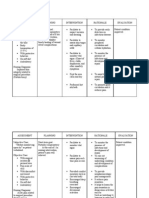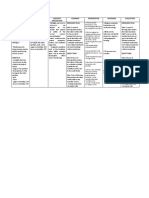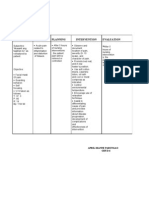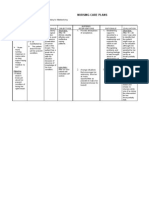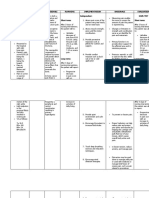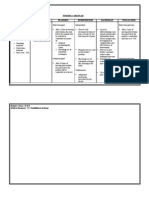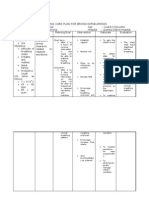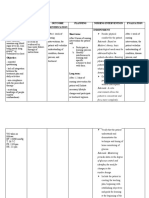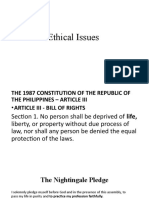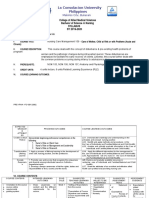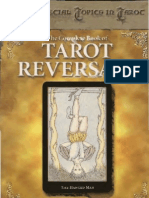NCP (Pre-Operative) : Assessment Nursing Diagnosis Planning Nursing Intervention Rationale Evaluation Subjective Cues
NCP (Pre-Operative) : Assessment Nursing Diagnosis Planning Nursing Intervention Rationale Evaluation Subjective Cues
Uploaded by
YessaminCopyright:
Available Formats
NCP (Pre-Operative) : Assessment Nursing Diagnosis Planning Nursing Intervention Rationale Evaluation Subjective Cues
NCP (Pre-Operative) : Assessment Nursing Diagnosis Planning Nursing Intervention Rationale Evaluation Subjective Cues
Uploaded by
YessaminOriginal Description:
Original Title
Copyright
Available Formats
Share this document
Did you find this document useful?
Is this content inappropriate?
Copyright:
Available Formats
NCP (Pre-Operative) : Assessment Nursing Diagnosis Planning Nursing Intervention Rationale Evaluation Subjective Cues
NCP (Pre-Operative) : Assessment Nursing Diagnosis Planning Nursing Intervention Rationale Evaluation Subjective Cues
Uploaded by
YessaminCopyright:
Available Formats
NCP (PRE-OPERATIVE)
NURSING DIAGNOSIS NURSING
ASSESSMENT PLANNING RATIONALE EVALUATION
INTERVENTION
Subjective Cues: Deficient knowledge After 1 hour of nursing Determine client’s ability, This Facilitates planning of After 1 hour of nursing
“Ano nga po ulit yung related to unfamiliarity intervention, the patient readiness, barriers to preoperative teaching intervention, the patient:
learning and level of program, identifies content
gagawin sa akin?” as with procedure as must: understanding. needs. Participated in learning
verbalized by the patient evidenced by request of Participate in learning process and treatment
clarification regarding the process and treatment Provides knowledge base regimen as evidenced
procedure regimen. Review specific pathology from which patient can make patients by active
and anticipated surgical informed therapy choices and
listening and asking for
procedure. Verify that consent for procedure, and
Objective Cues: Verbalize understanding appropriate consent has been presents opportunity to more information
Patient exhibit of condition, signed. clarify misconceptions. during health teaching.
apathetic behavior as perioperative process
observed by nurse and treatment. Objectives and goals must Verbalized
meet learner’s needs and not
State objectives and the instructor/nurse. understanding of
Patient exhibits Correctly perform outcomes to be achieved condition, perioperative
restlessness prior to necessary procedures clearly in learner’s terms This reinforces learning process and treatment as
procedure as observed and explain reasons for which is specifically evidenced by patient’s
by the nurse Use appropriate resource designed to facilitate verbalization of the
the actions teaching materials patient’s learning.
purpose of the operation
Patient state concerns Pre-operative procedures and rationale for pre-
regarding the Explain pre-operative helps reduce the possibility operative procedures
procedure and request procedures: NPO, Skin of postoperative and preparations.
preparation, holding of complications and promotes
for further information medications, prophylaxis a rapid return to normal body
and anesthesia medications function. Correctly performed
and state the reason for this necessary procedures
procedure. Relieves stress and and explained reasons
miscommunication and for the actions as
Inform patient or SO about prevent doubt about patient’s
itinerary, physician and SO wellbeing. evidenced by complying
communications. with NPO status and
Enhances patient’s skin preparations.
Explain about possible understanding or control and
intraoperative and post- can relieve stress related to
operative procedures and the unknown or unexpected.
expectations.
To determine client’s
learning and validate
information.
Provide for feedback and
evaluation of learning and
assist client for further
questions
NCP (POST-OPERATIVE)
PLANNING NURSING
ASSESSMENT NURSING DIAGNOSIS RATIONALE EVALUATION
INTERVENTION
Subjective Cues: Alteration in Comfort: After 5 hours of nursing Monitor skin color and Which are usually altered After 5 hours of nursing
“Sumasakit ang tahi ko. Acute Pain related to intervention, the client temperature and vital in acute pain. intervention, the client
Di ako makagalaw ng post-surgical procedure. will: signs. was able to:
maayos dahil sa sakit.” Report pain is relieved
as verbalized by the or controlled. Perform pain assessment To demonstrate Verbalized pain is
each time pain occurs. improvement in status and
patient relieved and controlled.
Document and investigate to identify worsening of
changes from previous underlying condition.
reports and evaluate Pain scale of 2/10.
results of pain
Objective Cues: interventions.
(+) Pain on incision
site Perform wound cleaning To diminish the irritability
and dressing. of the patient.
Pain scale of 5/10
Encourage To evaluate coping
(+) facial grimace
verbalization of abilities and to identify
feelings about the areas of additional
Restlessness pain such us concern.
concern about
Irritability tolerating pain,
anxiety, pessimistic
thoughts
Administer analgesics, as To maintain “acceptable”
indicated, to maximum level of pain. Notify
dosage, as needed. physician if regimen is
inadequate to meet pain
Provide comfort measures control goal.
(e.g., touch, repositioning,
use of heat or cold packs,
nurse’s presence), quiet To promote
environment, and calm nonpharmacological pain
activities management.
You might also like
- Food Coursework Gcse ExamplesDocument7 pagesFood Coursework Gcse Examplesafjwdfmkapgipn100% (2)
- Final NCP HerniaDocument5 pagesFinal NCP HerniaDenisse Shazz Mae Maret67% (3)
- Nursingcrib Com NURSING CARE PLAN Hepatitis ADocument2 pagesNursingcrib Com NURSING CARE PLAN Hepatitis APravesh Verma100% (1)
- Nursing Care Plan Impaire Physical MobilityDocument2 pagesNursing Care Plan Impaire Physical Mobilityderic90% (10)
- Nursing Care Plan 2Document2 pagesNursing Care Plan 2Isabel Barredo Del MundoNo ratings yet
- Nursing Care PlanDocument1 pageNursing Care Planapi-38118511380% (10)
- Discharge Plan For AppendicitisDocument2 pagesDischarge Plan For Appendicitismclubert100% (3)
- NCP. FistulectomyDocument2 pagesNCP. Fistulectomymitchelley80% (10)
- Thyroidectomy Nursing Care PlanDocument2 pagesThyroidectomy Nursing Care PlanRnspeakcom100% (1)
- Deficient Knowledge: Nursing Diagnosis Nursing Care Plans (NCP)Document3 pagesDeficient Knowledge: Nursing Diagnosis Nursing Care Plans (NCP)Vincent Paul SantosNo ratings yet
- Nursing Care PlanDocument3 pagesNursing Care PlanSophia Loraine Dorone Jesura100% (1)
- Nursing Care PlanDocument5 pagesNursing Care Planseanamir100% (5)
- Anxiety Related To Hospitalization and Disease Condition As Manifested by Fiscal Expression and VerbalizationDocument2 pagesAnxiety Related To Hospitalization and Disease Condition As Manifested by Fiscal Expression and VerbalizationmonaNo ratings yet
- Nursing Care Plan: Assessment Diagnosis Inference Planning Intervention Rationale EvaluationDocument3 pagesNursing Care Plan: Assessment Diagnosis Inference Planning Intervention Rationale EvaluationAbdallah AlasalNo ratings yet
- Activity IntoleranceDocument2 pagesActivity IntoleranceSenyorita KHaye100% (4)
- Risk For InfectionDocument2 pagesRisk For InfectionSuzette Rae Tate0% (1)
- Nursing Care Plan: Subjective DataDocument4 pagesNursing Care Plan: Subjective DataAbdallah AlasalNo ratings yet
- NCP Acute PainDocument4 pagesNCP Acute PainSj 斗力上No ratings yet
- Prostate Cancer NCPDocument1 pageProstate Cancer NCPKathleen Dimacali0% (1)
- Nursing Care PlanDocument20 pagesNursing Care PlanZamranosNo ratings yet
- CholecystitisDocument1 pageCholecystitisDianne ParungaoNo ratings yet
- Novilyn C. Pataray BSN - Ii: Assessment Diagnosi S Pathophysiolog Y Planning Interevention Rationale EvaluationDocument1 pageNovilyn C. Pataray BSN - Ii: Assessment Diagnosi S Pathophysiolog Y Planning Interevention Rationale EvaluationCharina AubreyNo ratings yet
- Chicken Pox N C P BY BHERU LALDocument2 pagesChicken Pox N C P BY BHERU LALBheru Lal100% (1)
- Pleural EffusionDocument5 pagesPleural EffusionTerizla MobileNo ratings yet
- Impaired Skin IntegrityDocument4 pagesImpaired Skin IntegrityVianah Eve EscobidoNo ratings yet
- Nursing Care PlanDocument12 pagesNursing Care Plankeishaaa29100% (6)
- NCP LaminectomyDocument4 pagesNCP LaminectomyMark Zedrix MediarioNo ratings yet
- NCP Impaired SkinDocument2 pagesNCP Impaired Skinarjay2306_obcq100% (1)
- "I Don't Have An Infection in My Gallbladder Which Is Good, But I Do Feel The Pain," As Verbalized by TheDocument2 pages"I Don't Have An Infection in My Gallbladder Which Is Good, But I Do Feel The Pain," As Verbalized by Theunnamed person100% (1)
- NCPDocument2 pagesNCPJhel NabosNo ratings yet
- Health Teaching Plan DyspneaDocument3 pagesHealth Teaching Plan DyspneaMae JavierNo ratings yet
- FHP & NCP - FractureDocument14 pagesFHP & NCP - FractureFrancis AdrianNo ratings yet
- Acute Pain OsteosarcomaDocument8 pagesAcute Pain OsteosarcomaMaryjoy Gabriellee De La Cruz100% (1)
- CP Intestinal Obstruction Nursing Care PlanDocument7 pagesCP Intestinal Obstruction Nursing Care PlanShiella Heart MalanaNo ratings yet
- NCP - Pediatrics Case Study (Pnuemonia With Down Syndrome)Document4 pagesNCP - Pediatrics Case Study (Pnuemonia With Down Syndrome)Charley DegamoNo ratings yet
- NCPDocument3 pagesNCPChrisTine M. MoralesNo ratings yet
- Nursing Care Plan: Assessment Diagnosis Inference Planning Intervention Rationale EvaluationDocument2 pagesNursing Care Plan: Assessment Diagnosis Inference Planning Intervention Rationale EvaluationJamie Haravata0% (1)
- Nursing Diagnosis Goal Interventions Expected Outcome: (List 5 Unique To The Given Nursing DX)Document3 pagesNursing Diagnosis Goal Interventions Expected Outcome: (List 5 Unique To The Given Nursing DX)joyrena ochondraNo ratings yet
- Nursing Care of Client With Cataract SurgeryDocument11 pagesNursing Care of Client With Cataract SurgeryFatin Fatihah Azizan100% (1)
- NCP AppendicitisDocument2 pagesNCP Appendicitismnms0708100% (2)
- NCP CholelithiasisDocument2 pagesNCP Cholelithiasiskmpg11100% (2)
- NCP For Activity IntoleranceDocument1 pageNCP For Activity IntoleranceKristine LonyenNo ratings yet
- NCP PancreatitisDocument2 pagesNCP PancreatitisJeanelle Generoso100% (2)
- Nursing Care Plan: Subjective Data " GoalDocument2 pagesNursing Care Plan: Subjective Data " GoalJay VillasotoNo ratings yet
- NCP AppendicitisDocument4 pagesNCP AppendicitisAisha LakibulNo ratings yet
- NCP Blood Glucose Imbalance 4thDocument2 pagesNCP Blood Glucose Imbalance 4thRainier IbarretaNo ratings yet
- Com +Nursing+Care+Plan+Chicken+PoxDocument2 pagesCom +Nursing+Care+Plan+Chicken+PoxDahl Obañana Erojo100% (2)
- NCP FeverDocument2 pagesNCP FeverMary Joyce LimoicoNo ratings yet
- NCPs For ParotidectomyDocument8 pagesNCPs For ParotidectomyAcohCChao100% (1)
- BPN NCPDocument6 pagesBPN NCPJoart EspinozaNo ratings yet
- Assessment Diagnosis Planning Intervention Rationale EvaluationDocument5 pagesAssessment Diagnosis Planning Intervention Rationale EvaluationArian May MarcosNo ratings yet
- Nursing Care Plan - 1 AlyanaDocument1 pageNursing Care Plan - 1 AlyanaKen100% (1)
- NCP Template ObDocument7 pagesNCP Template ObMae CeaesarNo ratings yet
- NCP Disturbed Sensory PerceptionDocument3 pagesNCP Disturbed Sensory PerceptionEdmarkmoises ValdezNo ratings yet
- Introduction To Clinical ReasoningDocument2 pagesIntroduction To Clinical ReasoningMa.Nicole Subong100% (1)
- Anxiety in WIlm's TumorDocument3 pagesAnxiety in WIlm's TumorDwinxelle Eiven CristobalNo ratings yet
- Assessment Nursing Diagnosis Outcome Identification Planning Nursing Intervention Evaluation IndependentDocument7 pagesAssessment Nursing Diagnosis Outcome Identification Planning Nursing Intervention Evaluation IndependentQueenie Silva100% (1)
- Independent: IndependentDocument4 pagesIndependent: IndependentGina PrancelisoNo ratings yet
- Clinical Teaching Plan DRDocument4 pagesClinical Teaching Plan DRCagabcab Canibel MelanyNo ratings yet
- Clinical Objectives For CICU 1st Week OctDocument2 pagesClinical Objectives For CICU 1st Week OctWaqas AliNo ratings yet
- Acute PainDocument4 pagesAcute PainRuffy AbdulazisNo ratings yet
- Herbal MedicineDocument5 pagesHerbal MedicineYessaminNo ratings yet
- Medical Surgical NursingDocument1 pageMedical Surgical NursingYessaminNo ratings yet
- Overview of The CaseDocument3 pagesOverview of The CaseYessaminNo ratings yet
- HERNIORRHAPYDocument2 pagesHERNIORRHAPYYessaminNo ratings yet
- DISCUSSIO1Document2 pagesDISCUSSIO1YessaminNo ratings yet
- Endoscopic Procedure (Nursing Responsibilities)Document4 pagesEndoscopic Procedure (Nursing Responsibilities)YessaminNo ratings yet
- MJDT Scholars FormDocument1 pageMJDT Scholars FormYessaminNo ratings yet
- Complete Blood CountDocument5 pagesComplete Blood CountYessaminNo ratings yet
- Data Gathering ProceduresDocument2 pagesData Gathering ProceduresYessaminNo ratings yet
- Metric System EquivalentsDocument2 pagesMetric System EquivalentsYessaminNo ratings yet
- A Case ofDocument55 pagesA Case ofYessaminNo ratings yet
- Subjective Cues: Independent: On The: "Nahihirapa N Ako Huminga" AsDocument5 pagesSubjective Cues: Independent: On The: "Nahihirapa N Ako Huminga" AsYessaminNo ratings yet
- 2 Ethical IssuesDocument86 pages2 Ethical IssuesYessaminNo ratings yet
- Vital Signs Checklist 1Document4 pagesVital Signs Checklist 1YessaminNo ratings yet
- HHVVHHDocument2 pagesHHVVHHYessaminNo ratings yet
- Childhood NutritionDocument7 pagesChildhood NutritionYessaminNo ratings yet
- NCM 102Document22 pagesNCM 102Yessamin100% (2)
- Adv Exp Med Biol 2020 Apr8 Maranta F PDFDocument24 pagesAdv Exp Med Biol 2020 Apr8 Maranta F PDFFernando SousaNo ratings yet
- Physical Education and Health Grade 11: Aerobics-Muscle-Bone-Strength-ActivitiesDocument28 pagesPhysical Education and Health Grade 11: Aerobics-Muscle-Bone-Strength-ActivitiesEmily T. NonatoNo ratings yet
- Industrial - Organizational Psychology TestDocument6 pagesIndustrial - Organizational Psychology TestMarlene BarsaloteNo ratings yet
- Assignment For Quiz 03 Assignment For Quiz 03: Organizational BehaviorDocument6 pagesAssignment For Quiz 03 Assignment For Quiz 03: Organizational BehaviorMasrur MoontamimNo ratings yet
- Sample 10 Prototype Testing PlanDocument1 pageSample 10 Prototype Testing PlanGrizelNo ratings yet
- Fispq Vitrolis - MM - 3020Document6 pagesFispq Vitrolis - MM - 3020yr45h6gf8nNo ratings yet
- Health Problems Illnesses Sickness Ailments Injuries Matching Exercise Vocabulary WorksheetDocument2 pagesHealth Problems Illnesses Sickness Ailments Injuries Matching Exercise Vocabulary Worksheetpepac414100% (4)
- DLL - Mapeh 5 - Q2 - W3Document5 pagesDLL - Mapeh 5 - Q2 - W3susan.maglasangNo ratings yet
- Asthma Action PlanDocument2 pagesAsthma Action PlanQuan DinhNo ratings yet
- Capstone Assignment - Group 3Document17 pagesCapstone Assignment - Group 3Stacey lukeNo ratings yet
- BSE KudaDocument53 pagesBSE Kudaasnita purnamaNo ratings yet
- QF 450 10 Rev. B Specification Log SheetDocument11 pagesQF 450 10 Rev. B Specification Log Sheetjianli wangNo ratings yet
- Diabetes Prediciton ModelDocument23 pagesDiabetes Prediciton Modelsatvik patil100% (1)
- Welcome To BFITIN30 The Home Work Out PlanDocument3 pagesWelcome To BFITIN30 The Home Work Out PlantaemnytsyaNo ratings yet
- JHA For ThrustboringDocument5 pagesJHA For ThrustboringoverhauldeglobalNo ratings yet
- Muhammad - Haris CV - Doc (LatestDocument2 pagesMuhammad - Haris CV - Doc (LatestMuhammad HarisNo ratings yet
- Prospectus: (CBSE AFFILIATION NO. 1930798)Document20 pagesProspectus: (CBSE AFFILIATION NO. 1930798)zymcaryNo ratings yet
- TKD Black Belt ThesisDocument7 pagesTKD Black Belt Thesisjuliekwhlanchorage100% (2)
- Chapter 5 Typical and A Typical Development Among ChildrenDocument44 pagesChapter 5 Typical and A Typical Development Among ChildrenJohn carlo TugayNo ratings yet
- Crime Preventive MeasuresDocument3 pagesCrime Preventive MeasuresNumra AttiqNo ratings yet
- Edm 619 Understanding Self and Others BrochureDocument34 pagesEdm 619 Understanding Self and Others BrochureVal TristanNo ratings yet
- Pdip 2023-2028Document7 pagesPdip 2023-2028elaiamapalo395No ratings yet
- Cardiac Depression Scale 26 Items - Hare 1993Document3 pagesCardiac Depression Scale 26 Items - Hare 1993TRIPTI RANINo ratings yet
- Box Breathing PDFDocument8 pagesBox Breathing PDFScribd AnonNo ratings yet
- ASSESSMENT TASK 2 NUrsing Management-1-QuinioDocument3 pagesASSESSMENT TASK 2 NUrsing Management-1-QuinioFe Malamal QuinioNo ratings yet
- Suicide Term Papers FreeDocument8 pagesSuicide Term Papers Freeafdttjcns100% (1)
- RXDocument283 pagesRXmarcel_prostNo ratings yet
- Sustainability 12 05067Document17 pagesSustainability 12 05067Alexutza StanNo ratings yet
- Compensation Practices: Table 8: Compensation Practices Among The Companies ACI, Pran RFL & Denim Expert in Bangladesh 10Document9 pagesCompensation Practices: Table 8: Compensation Practices Among The Companies ACI, Pran RFL & Denim Expert in Bangladesh 10Shahrukh HossainNo ratings yet







